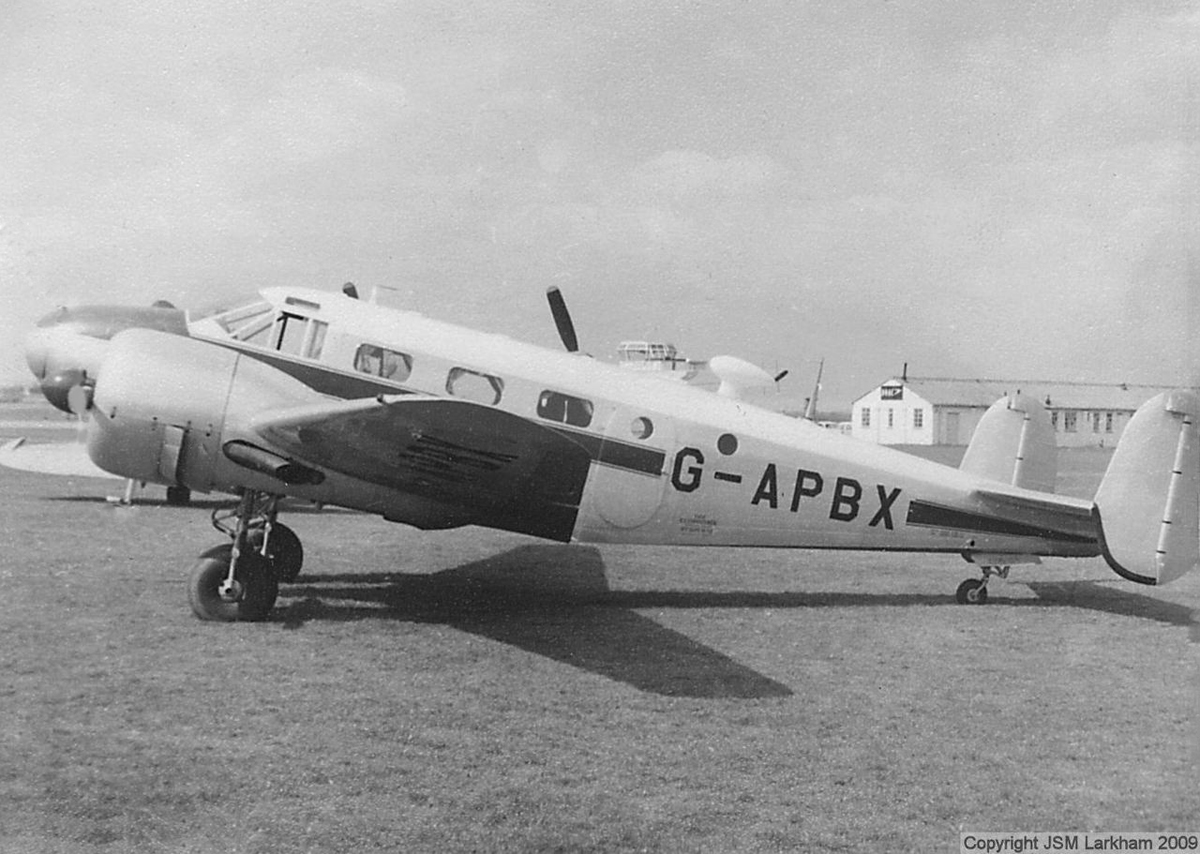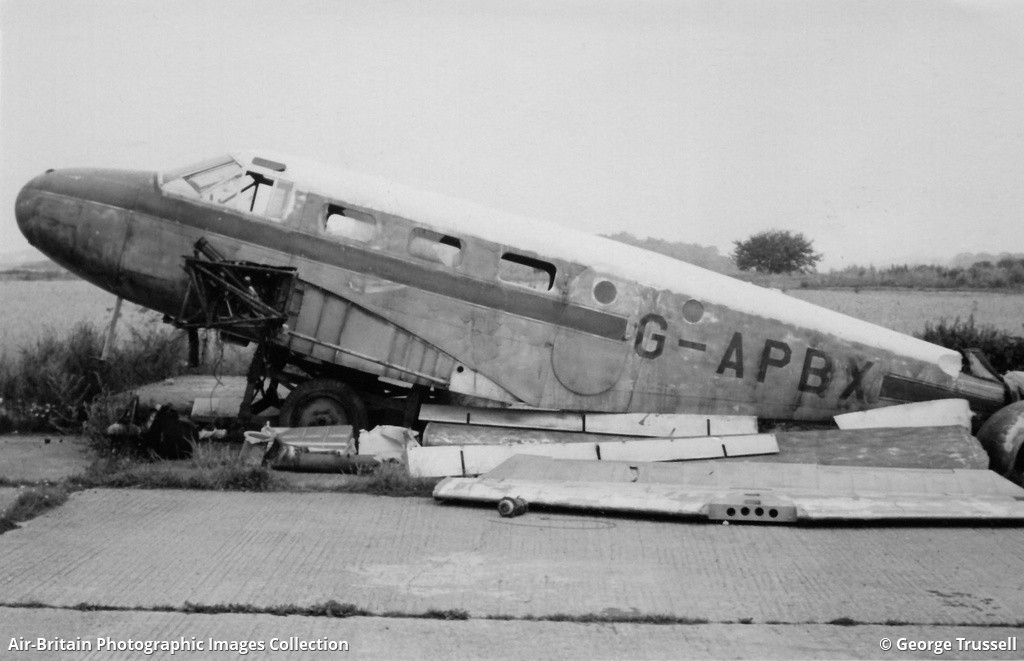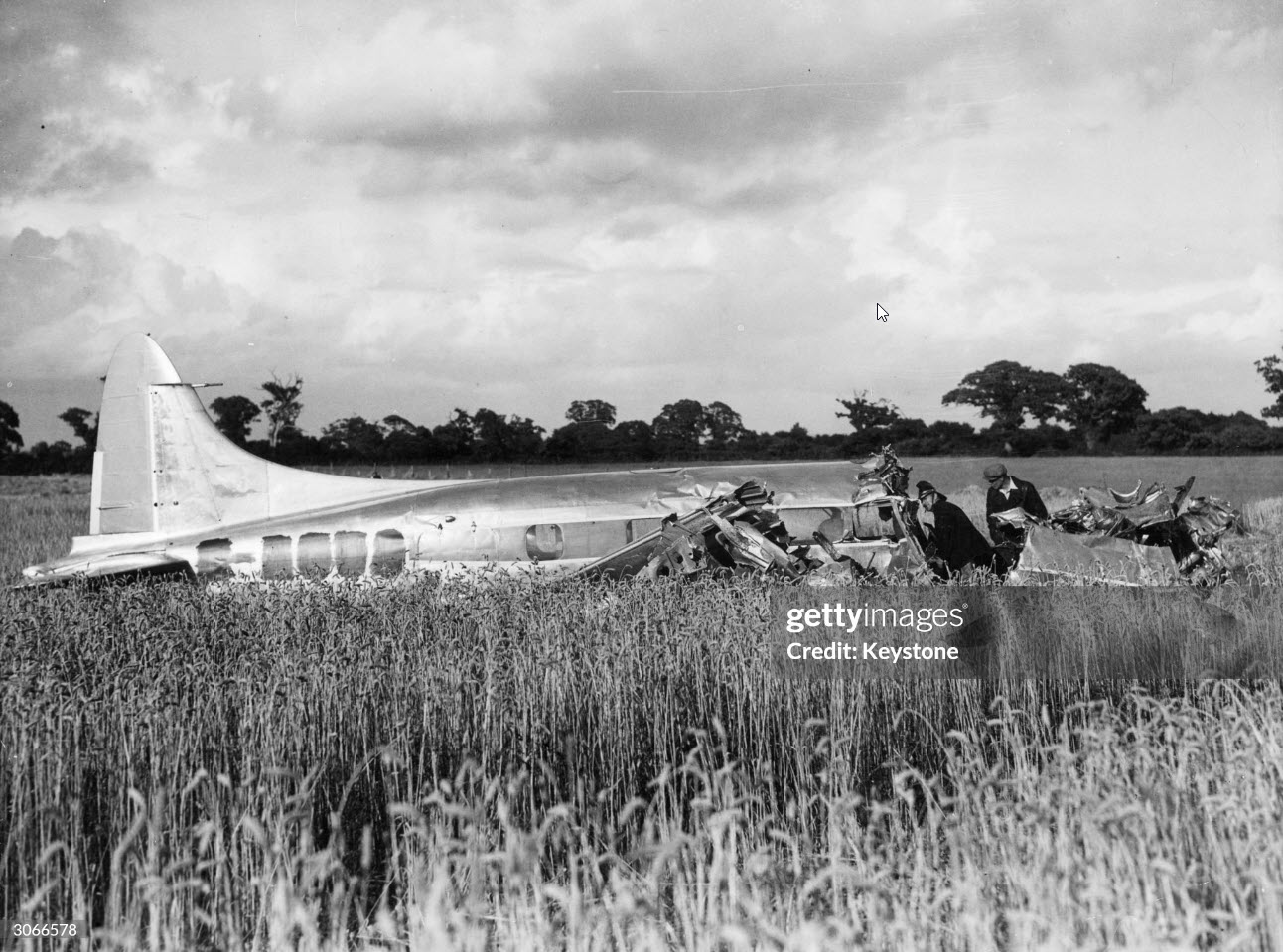Zone
Crash of a Bristol 170 Freighter 32 in Saint Peter
Date & Time:
Sep 24, 1963 at 1123 LT
Registration:
G-AMWA
Survivors:
Yes
Schedule:
Saint Peter - Bournemouth
MSN:
13073
YOM:
1953
Crew on board:
3
Crew fatalities:
Pax on board:
1
Pax fatalities:
Other fatalities:
Total fatalities:
0
Captain / Total hours on type:
5000.00
Copilot / Total hours on type:
1600
Circumstances:
The aircraft was returning to Bournemouth from Guernsey on a passenger and vehicle service flight. The copilot was flying the aircraft from the left-hand seat, and the pilot-in-command was performing the duties of the copilot. The engines were started at 1112 hours GMT. The brakes operated satisfactorily at this time. Following a normal run-up and check of the engines and the throttles were opened slowly because of a 17 kt crosswind component. The aircraft' reached a speed of 50 kt, and the rpm of the port engine began to rise. The pilot-in-command tried to control it by moving back the propeller control lever. The rpm commenced to surge and, as the aircraft's speed was then about 4 kt less than the single-engine safety speed (84 kt), the pilot-in-command ordered the copilot to abandon the takeoff. According to the testimony of the pilot-in-command following the accident, the brakes had little or no effect, and realizing that the aircraft would overrun the runway, he pulled back both propeller pitch control levers in order to stop the engines. Shortly before reaching the end of the runway the aircraft was turned to the left to avoid the approach lights. The aircraft became airborne for about 33 yd, then passed through the boundary fence of the stopway and struck a bank surmounted by a hedge where its port landing gear collapsed. Thereafter it crossed a hedge-lined road, and the starboard landing gear was deflected rearward. Finally it slid about 60 yd on its belly and stopped near a house. The accident occurred at 1123 hours GMT.
Probable cause:
The pilot-in-command abandoned the take-off due to a malfunction of the port power unit but was unable to bring the aircraft to a stop on the runway remaining.
Final Report:
Crash of a Beechcraft C18 Expeditor in Bournemouth
Date & Time:
Aug 5, 1959
Registration:
G-APBX
Survivors:
Yes
MSN:
A-0269
YOM:
1946
Crew on board:
0
Crew fatalities:
Pax on board:
0
Pax fatalities:
Other fatalities:
Total fatalities:
0
Circumstances:
Crashed in unknown circumstances. No casualties.


Crash of a De Havilland DH.104 Dove I in Chewton Common: 3 killed
Date & Time:
Mar 13, 1947 at 1808 LT
Registration:
G-AHRA
Survivors:
No
Schedule:
Bournemouth - Bournemouth
MSN:
4003
YOM:
1946
Crew on board:
2
Crew fatalities:
Pax on board:
1
Pax fatalities:
Other fatalities:
Total fatalities:
3
Circumstances:
Two pilots and one engineer were conducting a one hour test flight from Bournemouth-Hurn Airport. While circling around the airport, the crew encountered poor weather conditions but the captain informed ground he was able to reach the airfield. Shortly later, while flying at low height, the twin engine aircraft hit tree tops and crashed in a wooded area located in Chewton Common, southeast of the airport. All three occupants were killed.
It was reported in the final report that the flight was planned to obtain fuel consumption figures of the Gypsy 70 engine under cruising conditions & Captain R. G. Buck, the pilot, took off from Hurn at 1620LT, his intention being to carry out a flight of one hour duration below the cloud which was then at 1,200 feet. No notification of the flight was made to flying control until the time of take-off & no weather forecast was requested or given. It is presumed that the test was satisfactorily concluded for at 1714LT the Captain requested permission to join the circuit prior to landing. This was given together with weather information & Q.F.E. Weather conditions then began to deteriorate rapidly, cloud base lowering to 800 feet with rain. Capt. Buck gave his position as being over Bournemouth Pier at 1724LT and was instructed not to fly above 1,500 feet owing to the presence of another aircraft at 2,000 feet. Rockets & Very lights were fired & at 1735LT the pilot announced that he could see the airfield. He immediately carried out a left-hand circuit at an estimated height of 200 feet with the undercarriage down, at times going out of view into low cloud & rain. An approach at about 50 feet on runway 170 was attempted but the pilot failed to line-up with the runway & passed over the center of the airfield & disappeared in a right hand circuit. After a similar unsuccessful attempt to land, the controller gave permission for landing on any runway & gave further assistance by lighting sodium funnels. Capt. Buck then asked for a diversion stating " No radio, VHF not working & endurance three hours." At 1804LT he was told the best weather was in the London area & that London Airport had G.C.A & could work him on 5100 kc/s. The suggestion was not acted upon so the controller proposed he should make a further attempt to land at Hurn. Capt. Buck's reply was " Do not know where I am, but will try to find you." At approximately 1808LT the aircraft struck a row of trees & crashed in an adjoining copse. Weather conditions were bad with fine drizzle, a cloud base of 60 feet & visibility down to as little as 200 yards.
It was reported in the final report that the flight was planned to obtain fuel consumption figures of the Gypsy 70 engine under cruising conditions & Captain R. G. Buck, the pilot, took off from Hurn at 1620LT, his intention being to carry out a flight of one hour duration below the cloud which was then at 1,200 feet. No notification of the flight was made to flying control until the time of take-off & no weather forecast was requested or given. It is presumed that the test was satisfactorily concluded for at 1714LT the Captain requested permission to join the circuit prior to landing. This was given together with weather information & Q.F.E. Weather conditions then began to deteriorate rapidly, cloud base lowering to 800 feet with rain. Capt. Buck gave his position as being over Bournemouth Pier at 1724LT and was instructed not to fly above 1,500 feet owing to the presence of another aircraft at 2,000 feet. Rockets & Very lights were fired & at 1735LT the pilot announced that he could see the airfield. He immediately carried out a left-hand circuit at an estimated height of 200 feet with the undercarriage down, at times going out of view into low cloud & rain. An approach at about 50 feet on runway 170 was attempted but the pilot failed to line-up with the runway & passed over the center of the airfield & disappeared in a right hand circuit. After a similar unsuccessful attempt to land, the controller gave permission for landing on any runway & gave further assistance by lighting sodium funnels. Capt. Buck then asked for a diversion stating " No radio, VHF not working & endurance three hours." At 1804LT he was told the best weather was in the London area & that London Airport had G.C.A & could work him on 5100 kc/s. The suggestion was not acted upon so the controller proposed he should make a further attempt to land at Hurn. Capt. Buck's reply was " Do not know where I am, but will try to find you." At approximately 1808LT the aircraft struck a row of trees & crashed in an adjoining copse. Weather conditions were bad with fine drizzle, a cloud base of 60 feet & visibility down to as little as 200 yards.
Probable cause:
In the opinion of the Inspector the accident was the result of the aircraft striking trees whilst flying low in conditions of poor visibility. The only recommendation made was that the present location of the inertia crash switch be reconsidered. Owing to the high inertia required to actuate this switch it was felt that a position such as the belly of the fuselage adjacent to the nose of the aircraft would be more desirable.
Crash of an Avro 691 Lancastrian I in Bournemouth
Date & Time:
Aug 15, 1946
Registration:
G-AGLU
Survivors:
Yes
Schedule:
Bournemouth - Bournemouth
MSN:
1175
YOM:
1944
Crew on board:
4
Crew fatalities:
Pax on board:
0
Pax fatalities:
Other fatalities:
Total fatalities:
0
Circumstances:
During the takeoff roll, the crew lost control of the aircraft that veered off runway, lost its undercarriage and came to rest. There were no casualties but the aircraft was damaged beyond repair.
Crash of a De Havilland DH.104 Dove I in Bournemouth: 2 killed
Date & Time:
Aug 14, 1946
Registration:
G-AGUC
Survivors:
Yes
Schedule:
Bournemouth - Bournemouth
MSN:
04000/P/2
YOM:
1945
Crew on board:
1
Crew fatalities:
Pax on board:
3
Pax fatalities:
Other fatalities:
Total fatalities:
2
Circumstances:
Shortly after takeoff from Bournemouth-Hurn Airport, while on a local training flight, the captain encountered an unexpected situation and was forced to attempt an emergency landing. The twin engine aircraft went out of control and crash landed in a field near the airport. The pilot Captain Collier and a passenger, a De Havilland representative, Mr. North, were killed. Two other passengers, also BOAC employees, Mr. A. Pierce and P. Fawcett, were injured.

Crash of a Handley Page H.P.57 Halifax III in Moordown: 9 killed
Date & Time:
Mar 21, 1944 at 0100 LT
Registration:
JP137
Survivors:
No
Crew on board:
7
Crew fatalities:
Pax on board:
0
Pax fatalities:
Other fatalities:
Total fatalities:
9
Circumstances:
Shortly after take off from Bournemouth-Hurn Airport, while climbing by night, the crew encountered an engine failure and elected to return. While completing a turn at low height, the aircraft went out of control and crashed in a huge explosion in the district of Moordown, Bournemouth. All seven crew members were killed as well as two people on the ground. Several houses were destroyed in the accident.
Crew:
Sergeant Denis R. Evans, pilot,
Sergeant Henry W. Roberts, navigator,
Stanley A. Appleton, bomb aimer,
Sergeant George A. Alexander, wireless operator,
Sergeant Stanley F. Gent, flight engineer,
Sergeant Kenneth Green, air gunner,
Sergeant Reginald R. McGregor, air gunner.
Local resident:
Dorothea Bennett,
Percy F. Chislett.
Crew:
Sergeant Denis R. Evans, pilot,
Sergeant Henry W. Roberts, navigator,
Stanley A. Appleton, bomb aimer,
Sergeant George A. Alexander, wireless operator,
Sergeant Stanley F. Gent, flight engineer,
Sergeant Kenneth Green, air gunner,
Sergeant Reginald R. McGregor, air gunner.
Local resident:
Dorothea Bennett,
Percy F. Chislett.
Probable cause:
Engine failure.
Crash of an Armstrong Whitworth AW.41 Albemarle ST.II in Bournemouth
Date & Time:
Mar 7, 1944
Registration:
V1747
Survivors:
Yes
Schedule:
Bournemouth - Bournemouth
Crew on board:
0
Crew fatalities:
Pax on board:
0
Pax fatalities:
Other fatalities:
Total fatalities:
0
Circumstances:
While taxiing, the brakes failed. The aircraft veered off taxiway and collided with a transformer. Nobody was hurt while the aircraft was damaged beyond repair.
Probable cause:
Brakes failure.
Crash of a Armstrong Whitworth AW.41 Albemarle ST.II in Châteaudun: 5 killed
Date & Time:
Mar 4, 1944
Registration:
V1641
Survivors:
No
Schedule:
Bournemouth - Bournemouth
Crew on board:
5
Crew fatalities:
Pax on board:
0
Pax fatalities:
Other fatalities:
Total fatalities:
5
Circumstances:
The twin engine aircraft left Bournemouth-Hurn at 2112LT on 03MAR1944 on a parachute supply mission to the French Resistance. While approaching Châteaudun by night and at low height, the aircraft was shot down and crashed in a field. All five occupants were killed.
Crew:
Flight Officer C. J. Elmer,
Flight Officer J. H. Hood,
Flight Officer T. J. Adamson,
Sergeant E. J. Atkinson,
Sergeant J. Davies.
Crew:
Flight Officer C. J. Elmer,
Flight Officer J. H. Hood,
Flight Officer T. J. Adamson,
Sergeant E. J. Atkinson,
Sergeant J. Davies.


